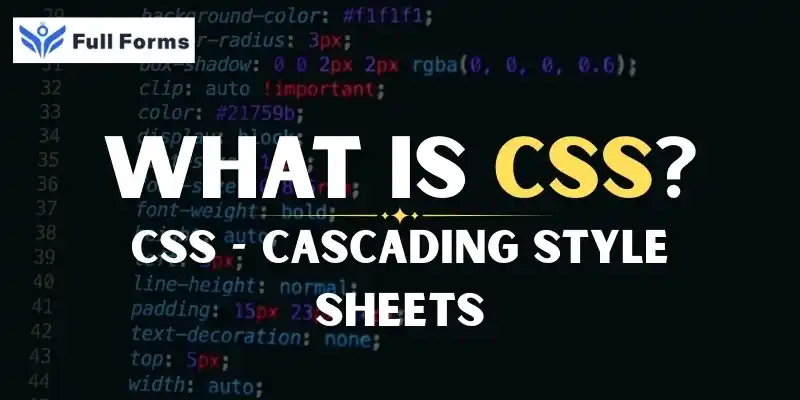Cascading Style Sheets
(CSS)

Description
CSS: Making Websites Look Better
Chances are you take in the colors, the fonts, and how everything is laid out on a page when visiting your favorite website. You must have at least once found yourself asking how a website attains its design. Here is the answer: Cascading Style Sheets or just CSS. Now, this is one vital section of web development that makes the site look appealing, systematic, and userfriendly. Here in this article, we will describe what CSS is, how it functions and why it matters .
Cascading style sheets
This is the style language that defines the look of web pages. In other words, content-wise, the structure done in a webpage through, say, headings, paragraphs, images which are done via HTML (HyperText Markup Language) markup-is kept separate from presentation; that is, the style applied to that structure is kept separately in CSS files; coloring, font design, spacing, borders-all these are a part of style.
Just imagine that, without CSS to design a web page would look like a skeleton in a closet and that’s not ever a good thing. Think of HTML as the foundation and walls of a house, and CSS as the paint, wallpaper, and decorations that make the house look nice.
How Does CSS Work?
CSS works by “finding” HTML elements and then applying style to them. For example, if you want all the headings on your site to be blue, you can use CSS to do that in these few lines of code:
h1 {
color: blue;}
}
It tells the browser to render all <h1> headlines in blue.
By adding CSS to a website, generally speaking, three principal approaches there are:
- Inline CSS: Styles are added straight to HTML elements through the style attribute.
- Internal CSS: Styles are coded within a <style> tag that is situated within the <head> section of the HTML document.
- Inline CSS: The style is written inside an HTML element, like the tag or the element. Not recommended as it makes the website slower, but useful for small modifications.
- External CSS: Styles are written in a separate file (ending with .css) and linked to the HTML file. This is the most common and best way to use CSS for big websites.
Most definitely, this little language is of great help for creating beautiful interface designs from scratch, for sure, but there’s much more one can pull off by utilizing CSS.
What You ‘Can Do’ With CSS?
CSS can give you loads of control as to how your website looks. Here are some things you can do:
- Change Colors: Set the background color or text color
- Typography: A mix of fonts and sizes applied to your words.
- Spacing: Margin and padding settings create space around elements.
- Layouts: Items organized in columns, rows, or grids.
- Borders and Shadows: Boxes with borders and shadows across elements
- Responsive Design: They ensure that your website is not ugly on phones or tablets due to fixed width layouts
This will make a common website look more up-to-date, professional, and easier to read.
Where Does the “Cascading” in Style Sheets Come From?
The term “cascading” refers to the way styles can flow from one place to another. With CSS, many rules can apply to one and the same element. In case two or more rules are proposing to style the same thing, CSS has a set of rules for determining which style “wins;” this is what is referred to as the cascade.
Let’s say you have a general rule that all text should be black, and then add a rule stating that headings should be red. CSS will apply the more specific rule first over the general rule when the two conflict. This is how this feature allows web designers to easily manage even complicated styles.
Why is CSS Important?
For several reasons:
- Separation of Content and Style: The HTML is kept clean with CSS because Content is separated from Presentation, allowing Concentration on Content rather than having Presentation mixed in with it. All presentation is made through CSS, making the sites easier to manage and update.
- Consistency: Since you can use the same CSS file for many pages, it's easier to keep the look— i.e. the design of the entire website consistent.
- Faster loading: Correct use of CSS will render your website faster since the style sheet needs to be downloaded just once by the browser.
- Accessibility: This helps the websites to become more user-friendly, allowing proper viewing for everyone including disabled people by handling issues like contrast and font size.
People usually learn CSS through
Starting with CSS is easy, but it's pretty much that if you want to get good at it. Much learning happens by:
- Reading online tutorials
- Watching videos
- Practicing by building your own very simple web pages
And there are plenty of free tools and resources out there to help you learn CSS.
Summary
CSS is what makes websites look good it is the ‘language’ counterpart to HTML’s structure. It allows for the addition of color, layout, and style to the HTML structure of a web page. It’s easy to learn, powerful stuff, and something you just have to know if you’re going to make web sites. So next time you’re admiring some awesome looking website, just remember that it’s the CSS doing all the work behind the scenes!
